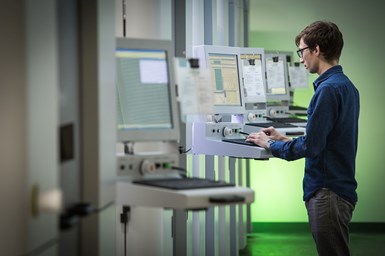Protolabs’ Vapor Smoothing Produces 3D Printed Parts With Enhanced Surface Finish
Process gives users all the advantages of additive manufacturing for parts while still achieving a surface finish that is comparable to injection molding.

Following production of the parts using selective laser sintering (SLS) or multi jet fusion (MJF), the team at Protolabs transfers the parts into a smoothing chamber which heats them and introduces a finishing agent. Photo Credit: Protolabs
Protolabs’ vapor smoothing process for 3D printed parts is an automated postprocessing technology designed to further enhance a plastic part’s surface finish on even the most complex geometries in additive manufacturing (AM). The process is currently available for the commonly used nylon material PA-12 as well as the elastic material TPU-01.
The company developed vapor smoothing to bridge the gap for additively manufactured parts to smooth and seal even the smallest cavities on the surface. According to the company, this enables AM parts to be used for a wider range of applications that demand a very fine smooth finish for aesthetic and functional reasons.
The process is also said to improve a part’s mechanical properties with increased elongation at break and impact strength, while the sealed and smoother surfaces are also water and airtight, and easier to clean.
Following production of the parts using selective laser sintering (SLS) or Multi Jet Fusion (MJF), the team at Protolabs transfers the parts into a smoothing chamber which heats them and introduces a finishing agent. Under carefully controlled conditions, this agent evaporates and the vapor spreads across all surfaces of the part. This causes them to melt, liquify and redistribute material to even out any peaks and troughs and seal even the smallest cavity.
Because the finishing process is automated, it can be used for more geometries than a manual smoothing process, which can be limited due to reaching difficult-to-access areas, the company says. This means that users can have all the advantages of AM for parts and achieve a surface finish that is comparable to injection molding, the company says.
Improved water tightness also opens up a number of applications, including tanks, fluid bearing pipes and ducts, valve covers and oil sumps. The medical sector and other industrial applications can also benefit from ease of cleaning due to a smoother surface.
Related Content
-
Freeform: Binder Jetting Does Not Change the Basics of Manufacturing
Rather than adapting production methodologies to additive manufacturing, this Pennsylvania contract manufacturer adapts AM to production methodologies. In general, this starts with conversation.
-
DMG MORI: Build Plate “Pucks” Cut Postprocessing Time by 80%
For spinal implants and other small 3D printed parts made through laser powder bed fusion, separate clampable units resting within the build plate provide for easy transfer to a CNC lathe.
-
3D Printed Lattice for Mars Sample Return Crash Landing: The Cool Parts Show Bonus
NASA Jet Propulsion Laboratory employs laser powder bed fusion additive manufacturing plus chemical etching to create strong, lightweight lattice structures optimized to protect rock samples from Mars during their violent arrival on earth.













